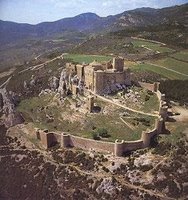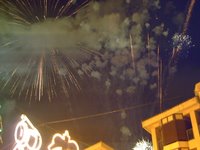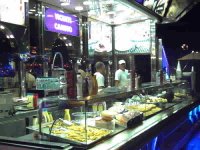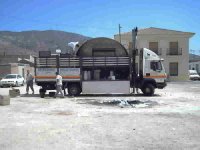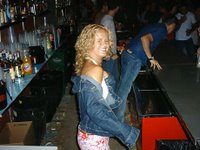
The Pinoso Festival started last night. Over the next eight days as well as the "permanent" market and fairground there are a number of one off events ranging from big name teen bands (Estopa) through bull running and on to giant free paellas in the street. Most of the town centre is closed to traffic.
César, one of the people who works on the local telly, had been chosen as the Prégon - a sort of key note speaker and town crier rolled into one - he made a speech about how wonderful Pinoso and its people were and, when he'd done, the lights decorating the town were turned on and all the big wigs processed through the town heading for the town gardens where four dance troupes from all over Spain were due to do their stuff.
We abandoned them at that point and had a stroll through the stalls and up to the fairground, watched the firework display, had a free game of bingo and greeted nearly every Spaniard we know in the area. Compelled by our sense of duty we decided to watch at least one of the dance troupes. The team on stage looked as though they may have been from Galicia but, fortunately, we never found out as we bumped into my bosses.
Julie likes to dance; she has been a professional dancer and a bit of a TV celeb, that partly explains the urge. She suggested we went to Beguts, which means drunkard in Valenciano.
Beguts is a Barraca - the dictionary definition of barraca is a hut or a shed but here what it means in this context is something closer to a warehouse party. The organisers take a very basic building, bung in a huge sound system and then pump out recorded and live music from about midnight till 8 in the morning.
Maggie's feet were aching before we got there. I'm just old. So as we dutifully trotted into this breezeblock compound, where the noise level was just right to make me deaf for a week, I spotted a portaloo, a gravel floor and an assorted group of young people who should been tucked up in bed after a nice cup of Ovaltine. My heart sank. A quick watch check revealed it was only about 1.30am; the night was still young. There was a bar though, and as Charlie pointed out, the organisers had made a point of putting good looking young women on the cash desk to help persuade young men to buy more drink. Old men do not need persuading to spend their hard earned cash on alcohol.
I felt better with a glass in my hand. We took up our position on the edge of the action. Jules shimmied a bit, Maggie did her best to join in. But as the night wore on the atmosphere amongst the crowd remained calm and friendly, the music seemed to become more tuneful and the night was warm. We moved closer to the action, we got another drink, we settled in. A drummer and singer (who may have been a man in my opinion despite wearing a frock) did their stuff. They were excellent. We left early, about 3.30am, to get some chips.
Not a bad start to the Fiesta and just a tad different to the Huntingdon Carnival

 Back in Mediaeval times when pilgrimages were all the rage The Way of St James, El Camino de Santiago, was considered to be right up there with Rome and Jerusalem as a top notch destination.
Back in Mediaeval times when pilgrimages were all the rage The Way of St James, El Camino de Santiago, was considered to be right up there with Rome and Jerusalem as a top notch destination. walking the route. One of the official "passports", the Credencial, serves both as a record of the journey and a way of obtaining cheap accommodation along the way. Pilgrims only have to walk 100kms or cycle 250kms to be able to exchange their Credencial for a certificate called the Compostela once they get to the Pilgrim's Office in Santiago but most of them look to have walked a lot farther than the minimum.
walking the route. One of the official "passports", the Credencial, serves both as a record of the journey and a way of obtaining cheap accommodation along the way. Pilgrims only have to walk 100kms or cycle 250kms to be able to exchange their Credencial for a certificate called the Compostela once they get to the Pilgrim's Office in Santiago but most of them look to have walked a lot farther than the minimum.

